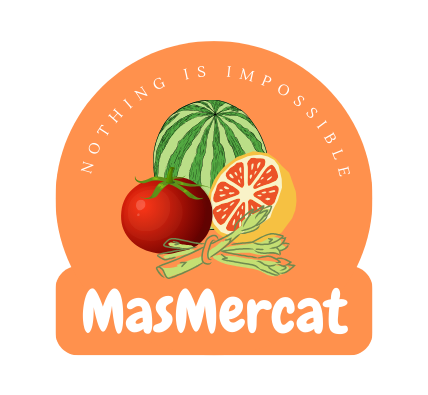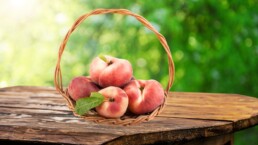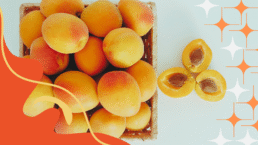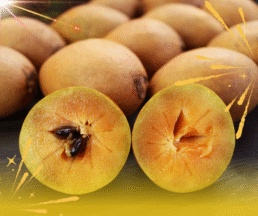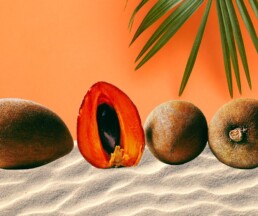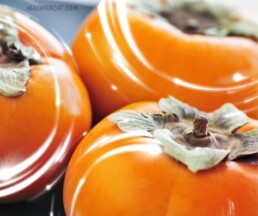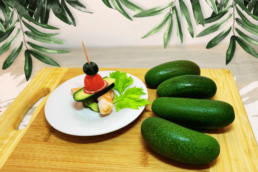Tree Bread (Jackfruit): The fruit that tastes like all fruits
As is customary, we'll talk about another fruit, this time an exotic one called Jackfruit (Yaca or Jaca), as we recently had the opportunity to try it in Mexico, where we witnessed its cutting and pulp extraction, which, by the way, is not easy at all. You need to keep some tips in mind if you don't want to end up with sticky hands and to know when it's ripe, otherwise, it will taste very acidic.
With a rough, green, and large appearance, the inside reveals the fibrous flesh surrounding the orange-colored arils when they are ready to eat. It has its own unique flavor but is somewhat reminiscent of papaya, mango, and pineapple, which is why some call it the "fruit-flavored fruit." Like most fruits, the riper it is, the sweeter it is, but the smell can be strong, even unpleasant for some sensitive noses. The fruit's ripeness can be recognized just by touching its skin; if it yields slightly, it is ready. It may also show brown tones on the skin, but the secret is not to let it pass that point, or the taste will no longer be optimal.
Its Origin
Jackfruit (Artocarpus heterophyllus) is a tropical fruit, native to South Asia and Southeast Asia; botanical and ethnobotanical evidence places it in the region between Southern India (Western Ghats) and Southeast Asia, where various varieties exist. It is currently found in several Latin American countries such as: Brazil, Venezuela, Ecuador, Peru, Colombia, Mexico, Guatemala, Nicaragua, and the Caribbean. Generally, it thrives in any Latin American country with a warm and humid tropical climate, from sea level up to about 1500 meters of altitude.
This fruit is known by various names such as jaca, nanca, langcá, panpén, or tree bread, among others.
How to Consume It and Care Tips for Peeling / Cutting (Practical Tips)
Regarding consumption: traditionally, in Asia, it is eaten both ripe (the sweet pulp) and green (cooked), and the seeds are also consumed, either boiled or roasted.
- For ripe Jackfruit: Eat the "arils" (the sweet segments) raw or in smoothies, ice creams, and desserts.
- For green (unripe) Jackfruit: It is used cooked in stews, stir-fries, curries, or as a meat substitute in tacos, burgers, or pulled-jackfruit.
- Seeds: They are boiled, roasted, or added to stews — they are edible and rich in starch.
- Trick for peeling without a mess: Smear the knife and your hands with neutral oil (this prevents the sticky sap from complicating the cutting). Cut the fruit lengthwise into quarters or halves, separate the rind, extract the woody core, and separate the arils by pulling away the fibrous tissue; remove the membrane surrounding the seeds. Use gloves if you prefer. These practical recommendations reduce stickiness and allow you to work safely. For more details, watch our video on our social media channels (RRSS).
Demand in Europe and Western markets has grown in recent years, driven by the plant-based trend and its use as a shredded meat substitute (a "pulled" texture). Market reports indicate sustained growth and increased presence in specialized supermarkets, vegan restaurants, and processed products.
Properties and Health Benefits
Jackfruit is nutritious: it provides carbohydrates, fiber, Vitamin C, potassium, and, notably, its protein content (2g) is high for a fruit. It also contains bioactive compounds (flavonoids, lignans) with antioxidant and anti-inflammatory potential. Studies reviewed in scientific literature list it as an interesting source of micronutrients and phytochemicals.
| Nutritional Component | Amount (per 100 g) | Key Contribution |
|---|---|---|
| Energy | 95 kcal | Medium caloric intake |
| Carbohydrates | 23 g | Main energy source |
| Sugars | 19 g | Responsible for its sweetness |
| Dietary Fiber | 1,5 - 2,5 g | Aids digestive health |
| Protein | 1,7 - 2,0 g | High for a fruit |
| Total Fats | 0,6 g | Very low fat content |
| Vitamin C | 10 - 14 mg | Potent antioxidant |
| Potassium (K) | 400 - 450 mg | Heart health and blood pressure |
| Magnesium (Mg) | 25 - 30 mg | muscle and bone function |
Global Production and Expansion
Today, jackfruit is widely cultivated in tropical and subtropical countries. India appears as the largest global producer, followed by Bangladesh, Thailand, and Indonesia; recent reports and agricultural authorities have highlighted India and Bangladesh as the main global suppliers. These are countries where it has been cultivated for centuries and where every part of the plant is widely utilized, from the termite-resistant wood of the tree to dyes for Buddhist monks' robes. Recent data show production concentrated in Asia (India, Bangladesh, Thailand, Indonesia, Sri Lanka). Parallel to this, the industry for processed products (canned goods, frozen pulp, vegetarian/vegan products) exporting to Europe and America has grown. Market analysts project moderate annual growth in the coming years due to the demand for plant-based alternatives.
Open Yourself to New Flavors
Die Jackfrucht ist eine vielseitige, schmackhafte Frucht mit bemerkenswerten Nährwertvorteilen. Wenn du sie noch nicht kennst, suche frische Jackfrucht auf ethnischen Märkten, in Dosenkonserven oder in veganen Produkten auf Jackfruit-Basis. Wage dich an neue Küchenexperimente – von Desserts mit reifer Frucht bis zu herzhaften Gerichten mit der grünen Pulpe. Sie ist nachhaltig, überraschend und für viele einfach köstlich.
Find out about our products here.
The Flat Peach and Flat Nectarine: Sweetness that Refreshes
During the hot summer months, few fruits are as refreshing and appetizing as the flat peach, also known as doughnut peach, paraguaya or its variant flat nectarine. This fruit, with its flattened shape and intensely sweet flavor, has won over taste buds around the world—especially in Spain, where its consumption grows year after year. But where does this peculiar fruit come from? What health benefits does it offer? And how should we consume it to make the most of its qualities?
Origin of the Flat Peach
The flat peach is a variety of peach (Prunus persica var. platycarpa), and its flat shape is the result of a natural mutation. Its origin dates back to China, where primitive versions were already being cultivated more than 2,000 years ago, as documented in ancient texts describing China’s long agricultural tradition. From there, it spread to Persia, the Mediterranean, and Europe, eventually reaching the Americas.
Its flattened form is believed to have arisen spontaneously as a mutation of the common peach tree, later selected for its intense flavor, thin skin, and juicy flesh
Different Names Around the World
This fruit is known by different names depending on the country or region:
Spain: paraguayo or platerina (the latter usually refers to the smooth-skinned variety, similar to a nectarine).
Latin America: durazno chato, durazno paraguayo, or melocotón plano.
English: doughnut peach, Saturn peach.
France: pêche plate.
Italy: pesca piatta or saturnina.
This variety has become popular in many countries for being sweeter and less acidic than traditional peaches, and for being easier to eat since the pit separates easily from the flesh.
Consumption in Spain and Worldwide
Spain is one of the leading producers and exporters of flat peaches in Europe, particularly in regions such as Murcia, Aragón, and Catalonia. The season runs from June to September, making it a star fruit of the summer. Spanish consumers value it for its sweetness, aroma, and pleasant texture.
Beyond Spain, the flat peach has also gained a presence, especially in gourmet markets and healthy eating circles. Countries such as the United States, Italy, and France have incorporated this fruit into their fresh produce markets as well as into products like juices, jams, and desserts.
Nutritional Properties
The flat peach is a highly nutritious fruit, low in calories and rich in water—making it ideal for hydration and weight-control diets. Below is an approximate nutritional breakdown per100 grams:
Nutrient | Approx. Amount |
Calories | 39 kcal |
Water | 87% |
Carbohydrates | 9.5 g |
Natural sugars |
|
Fiber | 1.5 g |
Protein | 0.9 g |
Fat | 0.3 g |
Vitamin C | 10 mg (17% VD) |
Vitamin A (beta-carotene) | 326 IU |
Potassium | 190 mg |
Magnesium | 9 mg |
Health Benefits
Eating flat peaches offers a range of benefits that go beyond their refreshing taste: they provide natural hydration, deliver antioxidants that help combat oxidative damage, supply fiber that supports healthy digestion, improve cardiovascular function thanks to their potassium content, and are also ideal for a healthy diet as they are low in calories.
What’s the Difference Between the Flat Peach and the Flat Nectarine?
The difference lies not in the species, but in the skin texture and subtle variations in taste and appearance.
Both belong to the same species (Prunus persica var. platycarpa ), a flat variety of peach.
Characteristic | Flat Peach | Flat Nectarine |
Skin | Velvety (with fuzz) | Smooth (no fuzz) |
Flavor | Sweet, juicy, aromatic | Sweet, firm, slightly crisper |
Appearance | Mixed, less uniform colors | Brighter, more uniform colors |
Origin | Flat peach variety | Flat, fuzz-free variety, similar to nectarine |
How to Enjoy it
The flat peach can be enjoyed in many ways: The traditional one is to eat the fruit well-washed and in season, or to add it to a good salad to bring a sweet touch. At breakfast or as a dessert, it pairs wonderfully with yogurt or curd. Another very healthy option is to grill it, which enhances its sweetness and makes it an ideal side dish.
Finally, you can make the most of its sweetness by blending it with plant-based milk or yogurt and ice, without added sugar, resulting in a refreshing, nutritious drink with balanced sugar content—perfect for beating the summer heat. And if you want even more nutrients, you can add seeds such as chia or flax. In smoothies, blended with plant-based milk or yogurt, ice, and no added sugar for a refreshing, nutrient-rich summer drink. For an extra nutritional boost, add seeds like chia or flax.
This summer, you can enjoy the refreshing taste of the flat peach a healthy, versatile, and delicious fruit that continues to earn its place in the Mediterranean diet and beyond.
So if you haven’t tried it yet, summer is the perfect time to savor this juicy, delightful gift of nature.
For more information, explore our products here.
Apricot: The King of Summer
The apricot is not just a symbol of summer—it's a fruit from the Far East, a great ally for health, and a delight in the kitchen.
Its Origin
The apricot belongs to the Rosaceae family and its scientific name is:
Prunus armeniaca
Interestingly, the scientific name refers to Armenia, one of the countries through which the fruit spread to Europe, although its origin traces back to Central Asia and China.
A Bit of History: The Apricot in Spain
It is believed that the Arabs introduced apricot cultivation to the Iberian Peninsula during the Middle Ages. In Arabic, it was known as al-barqūq, a word from which the current Spanish name albaricoque is derived.
A very Spanish curiosity: in Murcia, the main producing region, the apricot is so ingrained in the local culture that there are popular sayings like:
"You’re more Murcian than an apricot"
And rightly so, since Murcia leads national apricot production, with traditional varieties like Bulida, highly prized for their sweet and juicy flavor.
Each region harvests a fruit that reflects the characteristics of its soil, climate, variety, and the care given by the farmer—making each apricot uniquely distinctive. Here’s an example:
Nutritional Content of Apricots (per approx. 100g)
_______________________________________________________________
Nutrient Approx. Amount
Energy 48 kcal
Water 86%
Protein 1 g
Carbohydrates 11 g
Natural Sugars 9 g
Fiber 2 g
Fats 0.4 g
Vitamin A 96 mcg (12% RDI)
Vitamin C 10 mg (12% RDI)
Potasiumm 259 mg
Beta-carotene 1094 mcg
________________________________________________________________
✅ Low in calories, ideal for snacking
✅ Rich in vitamin A and beta-carotene, protects skin and eyesight
✅ Source of vitamin C, boosts the immune system
✅ Contains potassium, supports heart and muscles
✅ Provides fiber, beneficial for digestion
Apricots and Sun Protection
Thanks to their beta-carotene and antioxidant content, apricots help protect the skin from sun damage and promote a healthy tan… though they should never replace sunscreen!
Season and Growing Regions
In Spain:
• Season: April to July
• Main regions: Murcia, Valencia, Alicante, Aragón
Worldwide:
• Turkey – world leader
• Iran, Uzbekistan – historic major producers
• Italy, France – known for high quality
•Morocco and Tunisia – key in the Mediterranean
Quick Regional Summary
| Region | Notable Varieties | Climate | Main Season |
|---|---|---|---|
| Murcia | Bulida, Currot, Mitger, Redixia | Dry Mediterranean, hot summers | April - June |
| Comunidad Valenciana | Canino, Ginesta, Currot | Mild Mediterrean, sea breeze | May - July |
| Aragon | Moniquí, Mitger, Bulida, Faralia | Mild Continental, warm summers | Late May - July |
Each area brings its own signature to the apricot: from the sweetness and size of those from Murcia, to the balance and juiciness of those from Valencia, and the intense, traditional flavor of those from Aragón.
Choose your favorite and enjoy summer naturally! ☀️🍑
How to Eat and Enjoy Them
✔️ Fresh, as a snack or in salads
✔️ Dried, perfect for snacking or baking
✔️ In jams and compotes
✔️ In savory dishes like tagines and stews
✔️ In tarts, yogurts, smoothies, or desserts
A bite of apricot is history, health, and flavor. Take advantage of the season to enjoy its benefits and sweetness—and remember:
If you want to care for yourself from the inside out and show off radiant skin, the apricot is your ally.
For more information, explore our products here
Chicozapote: The Fruit of the Chewing Gum Tree
Once upon a time, somewhere in Mesoamerica and the central-southern region of the American continent, deep within the tropical rainforest—where fruit-bearing trees were treasures waiting to be discovered—stood out a tree and its remarkable fruit known as chicozapote. In this article, we’ll explore this unique fruit, its origin, key characteristics, health benefits, and its economic importance.
Fruit of a Sacred Tree
In pre-Hispanic times, various ancient cultures—most notably the Maya and Aztec civilizations—held this tree in high regard. From it, they extracted a milky sap that thickened into an elastic, gum-like substance.
This was the earliest form of chewing gum, highly valued not just for freshening breath or cleaning teeth, but also for its ceremonial use as a sacred offering. Over time, the tree itself came to be considered sacred.
But beyond its prized sap, the tree also bore a beloved fruit: chicozapote, known as sapodilla in the Canary Islands, and often referred to as níspero in the Dominican Republic, Colombia, and Panama.
What does "chicozapote" mean in Nahuatl?
“tzictli” (gum or resin) and “tzapotl” (a general term for soft, sweet fruits).
So, in Nahuatl, chicozapote means:
“Sapote of the gum” or “fruit of the gum tree.”
Nutritional Properties
Manilkara zapota is the scientific name of the chicozapote, a fruit with a rough texture, brown color, sweet and juicy pulp, and black seeds—known for its unique flavor. Among its main nutrients are natural fiber, vitamins A, C, and B complex. The primary minerals it contains include potassium, iron, and calcium, as well as antioxidants. This nutritional content makes the fruit a source of health; with its stream of nutrients, consuming it helps strengthen the body.
Main Health Benefits
Like most fruits and vegetables, chicozapote is best enjoyed as part of a balanced and varied diet.
When consumed regularly, it can provide a range of health benefits:
- Improves digestion, thanks to its high fiber content
- Strengthens bones and teeth, due to calcium and phosphorus
- Regulates blood pressure, with its natural potassium
- Boosts the immune system, thanks to its vitamin C
- Provides natural energy, perfect for athletes or anyone needing a healthy lift
Recent studies have also explored its antimicrobial and anti-inflammatory properties, reinforcing its role as a natural superfruit.
Tips to Eat It at the Perfect Time
Chicozapote is typically harvested before it's fully ripe to ensure freshness during transport and display—whether in local markets, supermarkets, or grocery stores.
This makes it essential to know when it's at its optimal ripeness for consumption.
An important aspect to consider is that it should feel soft to the touch, similar to an avocado. If it’s too hard, it still needs time to ripen; if it’s too soft or has sunken spots, it may be overripe. Another point to keep in mind is the color of the skin, which becomes more dull and earthy when ripe. Sometimes, it may show small rough patches without affecting the inside.
It should be easy to peel with a knife or by hand, and it should have a pleasant smell. If it doesn’t have any scent, it’s likely still unripe. Finally, if you bought it while still unripe, let it ripen at room temperature for 3 to 5 days, just as you would with a mango or a banana.
A Fruit That Deserves a Place at Your Table
In a world longing for authenticity, chicozapote is a perfect example of how ancestral wisdom and modern living can coexist. Rich, nutritious, and steeped in history, this fruit reminds us that nature has so much to offer—if we know where to look.
So next time you see it at a market or in a traditional recipe, don’t hesitate: chicozapote is wellness in its sweetest form.
→ Learn more about our products with just one click.
Mamey: El Fruto Tropical que Debes Probar
As we have done with our previous articles on fruits, this one is dedicated to a lesser-known, exotic fruit. We hope this article sparks your interest and encourages you to try it.
Mamey (Pouteria sapota), also known as Zapote, is a tropical fruit of great historical, cultural, and economic significance in Mesoamerica and the Caribbean. With its unmistakable flavor and creamy texture, this exotic fruit has captivated those seeking a natural and nutritious delicacy.
Origin and History
Archaeological evidence suggests that mamey has been part of indigenous diets for over 2,000 years. It was highly valued not only for its sweet taste and high energy content but also for its medicinal properties. Pre-Hispanic codices and colonial chronicles reference this fruit as a key element in Mesoamerican trade.
With the arrival of Spanish colonizers, mamey spread to other tropical regions of the Americas, including Mexico, Cuba, the Dominican Republic, and parts of South America. Today, it is a popular fruit in various countries and is primarily cultivated in warm, humid climates.
The leading producers of mamey include Mexico, Cuba, the Dominican Republic, Costa Rica, and several Caribbean and South American countries, where tropical climates support optimal growth.
What Are Its Health Benefits?
Mamey is not only delicious but also packed with essential nutrients that offer numerous health benefits. Some of its key components include:
Rich in Vitamins A, C, and E, supports eye health, strengthens the immune system, and protects the skin against aging. Rich in Vitamins A, C, and E, supports eye health, strengthens the immune system, and protects the skin against aging.
Loaded with Natural Antioxidants– The presence of carotenoids and polyphenols makes it an excellent ally against free radicals, reducing the risk of chronic diseases.
Contains Healthy Fatty Acids , these natural oils benefit cardiovascular health and help keep the skin hydrated.
Su contenido en carotenoides y polifenoles lo convierte en un excelente aliado para combatir los radicales libres y reducir el riesgo de enfermedades crónicas. Además de ácidos grasos saludables, contenidos en su pulpa, estos aceites naturales benefician el sistema cardiovascular y mantienen la piel hidratada.
How to Identify a Good Mamey Fruit
Mamey is a medium to large-sized fruit with a thick, rough brown skin that protects its vibrant orange or reddish pulp. The flesh has a creamy, smooth texture, similar to that of an avocado, and its sweet flavor carries hints of almond and vanilla, making it highly prized in culinary applications. At its center lies a large, dark seed, often used in traditional remedies and mamey oil production.
Mamey Consumption in Europe
In recent years, mamey has gained popularity in Europe due to the growing demand for exotic and healthy foods. Although its distribution remains limited compared to other tropical fruits, it can be found in specialty markets and Latin American food stores. Countries like Spain and France have shown increasing interest, particularly within Latin American immigrant communities and gourmet cuisine, where it is used in desserts and beverages.
Mamey in the Industry
One of the standout byproducts of mamey is its seed oil, widely used in hair and skincare treatments. This oil is known for:
- Preventing hair loss
- Acting as a natural conditioner
- Controlling frizz
- Strengthening eyelashes and nails
- Providing heat protection for hair styling tools
For skincare, mamey oil serves as a natural emollient with moisturizing, antioxidant, and anti-inflammatory properties, making it ideal for skin protection and regeneration.
Additionally, it has therapeutic and medicinal uses, such as:
- Treating various scalp and skin conditions
- Relieving insect bites and irritations
- Moisturizing chapped lips
- Enhancing relaxation through massages
Culinary Uses of Mamey
Mamey is a versatile fruit that can be enjoyed in multiple ways. It is often eaten fresh by simply cutting it in half and scooping out the flesh with a spoon. It is also a key ingredient in smoothies, ice creams, desserts, jams, and even savory sauces. Its natural sweetness makes it a great alternative to refined sugars in various recipes.
Our top recommendation is a mamey smoothie with skim or plant-based milk—no added sweeteners needed, as the fruit is naturally sweet.
To fully enjoy its flavor and benefits, it is best to select mameys at their peak ripeness when their skin slightly yields to pressure and emits a sweet aroma.
Dare to try mamey and find out why it is considered a tropical treasure full of flavor and nutrition! Get to know our products, just with a click.
Divine Fire Fruit: The Persimmon
A very familiar name in our shopping basket during the autumn-winter season, also called Sharoni (Triumph), Persimon, Kaki, or Palo Santo.
We’ve decided to dedicate this space to delve a little into its history and how it has earned a special place in consumers’ preferences.
Where Did It Originate?
Divine Fire Fruit: The PersimLike several fruits we’ve discussed in our blog, its origin lies in Asia—specifically China and Japan. Its scientific name is "Diospyros kaki", which means "fruit of the divine fire." In Japan, it is associated with longevity and good fortune, and in many cultures, it symbolizes perseverance and inner strength.
Beyond its symbolism, it is a fruit with rich traditions, sweetness, and numerous health benefits.
In Spain, it was introduced in the 18th century and was warmly received, eventually earning a strong foothold in the fields of Spanish farmers. This is particularly true in the Ribera Alta region of the Valencian Community, where it has flourished with great success and is now the second-largest persimmon-producing region in the world. This effort resulted in the creation of the "Kaki Ribera del Xúquer" Designation of Origin, which we will discuss in greater detail in this article.
Today, Spain, along with Italy, are the largest producers in the European region.
A Unique Flavor?
This is a topic of much discussion among consumers, as persimmons can sometimes be slightly bitter in certain varieties. This characteristic is due to tannins, which give the fruit its astringent taste, leading to classifications as astringent or non-astringent varieties.
Some astringent varieties include: Rojo Brillante, Eureka, Hachiya, and Koushu-Hyakume, which must be eaten when very ripe to avoid astringency. At this stage, the fruit’s texture becomes so soft that it can even be eaten with a spoon. In the case of the Rojo Brillante variety, once the astringency is removed, it is known as Persimon, a protected brand name. After post-harvest treatment, it retains its firmness and develops a sweeter taste.
Non-astringent varieties include: Jiro, Sharon, Honan Red, and Fuyu, which naturally mature until the fruit becomes softer and sweeter.
However, the fruit's soft flesh posed a challenge for commercialization, leading to the search for alternative ripening techniques to produce a sweet yet firm-textured fruit.
With the support of the Valencia Agricultural Research Center and based on the Rojo Brillante variety, a fruit oxidation process was developed, resulting in the Kaki Ribera del Xúquer Designation of Origin mentioned earlier. This product is characterized by firm consistency, an intense orange skin and flesh, a good size, and a sweet flavor.
This innovation has been a great success, enabling easier handling and access to international markets, significantly expanding over the last twenty years.
What Are Its Health Benefits?
The persimmon harvest season in Spain runs from October to January, coinciding with colder weather and the onset of colds and flu. Maintaining a strong immune system is crucial during this time. Nature provides us with many fruits to strengthen our immune systems, from delicious citrus fruits to flavorful berries like persimmons, which offer numerous nutrients.
It contains:
- Antioxidants– Fight free radicals, thereby boosting the immune system.
- Calcium– Strengthens bones.
- Potassium– Improves heart health, blood pressure, and arteries.
- Vitamin A - Enhances eye health.
- Vitamin C - Improves iron absorption and skin appearance.
- Flavonoids - Beta-carotenes that boost the immune system.
- Fiber – Improves digestion and regulates intestinal transit, as soluble fiber retains water and reduces cholesterol levels.
These nutrients make persimmons an excellent addition to your diet, especially during the autumn and winter seasons when they are at their peak. We encourage you to maintain a balanced and healthy diet along with regular exercise. We encourage you to maintain a balanced and healthy diet, as well as a regular exercise routine.
We invite you to explore our products.
Discover the Date or Cocktail Avocado
The date or cocktail avocado, a gift of nature and a delight for avocado lovers. Seedless and boasting an unparalleled creamy texture, this exotic fruit will transport you to a world of subtle and delicate flavors. Perfect for creating gourmet dishes and unforgettable culinary experiences.
What makes the date avocado unique is that it is the immature fruit of a common avocado variety, such as Fuerte or Bacon. Due to a natural or induced process, the fruit's embryo fails to develop, resulting in a seedless, smaller avocado.
The date avocado is a variety originally from Israel It is smaller than conventional avocados and has an elongated shape, similar to a finger or a small cucumber. Its skin is thin, edible, and dark green, while its flesh is light green and very creamy. To enjoy it, it must be soft to the touch. To enjoy it, it must be soft to the touch.
Where is it grown?
In regions like Andalusia (Málaga, Granada), the cultivation of date Date avocados are grown in Israel and other Mediterranean countries, including Spain. avocados has significantly increased in recent years and is gradually expanding to areas like Valencia. The warm and sunny climate of these regions supports its growth.
The fruit is hand-harvested and carefully selected to ensure quality. It is highly versatile and can be used in a variety of dishes, whether eaten on its own, in salads, sandwiches, guacamole, or smoothies.
What are its nutritional benefits?
Like other avocados, the date or cocktail avocado is an excellent source of healthy fats, fiber, and vitamins such as vitamin E, potassium, and folic acid—essential nutrients for good health.
It is a fantastic choice for those seeking a healthy and delicious fruit.
"Let food be your medicine, and medicine be your food." – Hippocrates
Considered an exotic fruit with limited production, it is classified as a gourmet product.
You can find various recipes on our social media channels. And for more information about the date avocado, feel free to contact us here.
